Home
KASHBA Asiatica
Ais Loupatty
Ton Lankreijer
Staalstraat 6
1011 JL Amsterdam
Open 12:00 – 17:00
Zondag / Sunday 14:00 - 17:00
Contact:
31-20 - 6 23 55 64
06 - 588 41 370

Saints, heroes, and other phantoms.

Wat Phra Singh, May ‘22, Chang Mai
‘People have always sought answers to the great existential questions about the meaning of birth, life, and death. When the answers cannot be put into words, images or symbols (from the Greek symballein - to coincide) can speak.’

‘Inner processes are projected outward; thinking in analogies is based on this. What we perceive is what we recognize or, rather, what appeals to us.
An image only acquires meaning when it connects with our inner selves, in other words, when it resonates with us. It is never ‘just’ images that become iconic in art.’
- W. Welling in Goddelijk en griezelig.
I have no idea whether hyper-realistic design blew over from the Western art world in the nineties or if it emerged independently in Asia.
Perhaps it happened simultaneously in both places and mainly because it had become technically possible.
Quite suddenly, I noticed remarkably detailed, almost lifelike wood carvings appearing in the better markets of Bangkok. Initially, these were mainly skilfully and realistically carved crocodiles and elephants.
It didn't occur to me to buy one. They looked eerily real, lacked any personal interpretation or design vision from a creator, and were therefore rather dull. It was as if a 3D printer had produced a perfect copy.
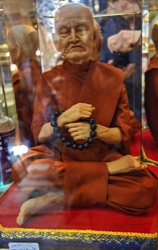
Similar figurines of national heroes and saints soon followed.
These eerily realistic figures had something disturbing about them when viewed up close.
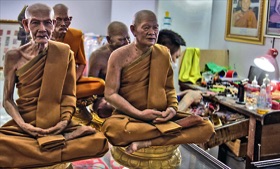


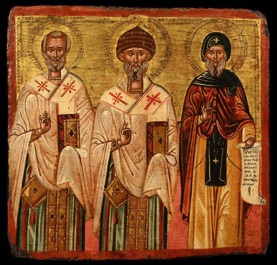
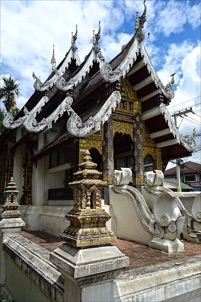
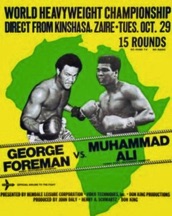
By far the most famous name was that of the boxer Mohammed Ali. His fight with George Foreman in Congo (now the Democratic Republic of the Congo) on 30 October 1974 was broadcast worldwide.
'The Rumble in the Jungle’ was watched by an estimated one billion television viewers – a record at the time.
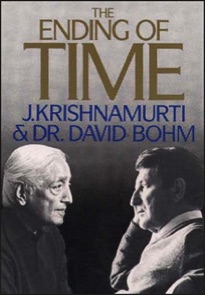
Doesn’t identifying with a hero or saint not lead to imitation? To pretext and pretence? Or as J. Krishnamurti puts it: ‘A mind that does not investigate for itself becomes dull and boring. It conforms to the model. To the ritual, to the film star, scholar or guru.’
‘There is conformity when there is comparison. The mind stops questioning, searching and observing its own workings and becomes mechanical.’
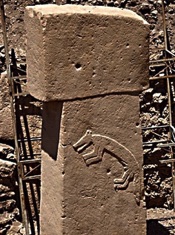
The earliest known temples feature primarily animal figures. These figures embodied characteristics and traits that were immediately recognised by every human being.
The imagery is also ever-present in language, with phrases such as 'as fearless as a lion', 'as steadfast as an elephant' and 'as proud as a peacock’, etcetera.
In the case of Göbekli Tepe, a temple hill in south-eastern Anatolia, Turkey, Wikipedia speaks of abstract pictograms. 'These signs cannot really be called script, but perhaps they are generally understandable (sacred?) symbols for that time, as they have also been found in cave drawings from the early Stone Age.'
In other words, in the ancient, spiritual sense, a symbol refers to a spiritual world. It refers to another dimension that one senses but cannot put into words.
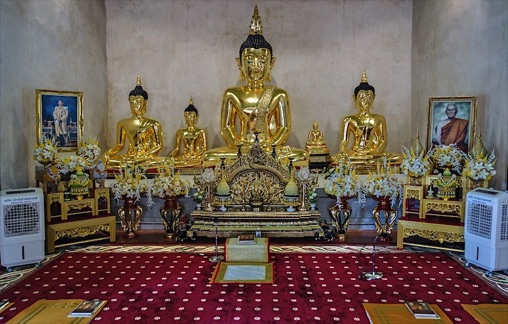
With worldly and spiritual power on either side.

At first glance, a Buddha statue resembles a historical hero or saint from around 2,500 years ago. However, the statue is nothing more than a symbolic reference.
His left hand touches the earth to indicate that you can indeed escape the suffering that is called the world. Not because he ‘demonstrated how it's done’, but by studying his findings from self-examination.
In person, the statue would topple forward as soon as he stood up. His right arm would extend past his knee. Not to mention the tuft of curls on his head – reminiscent of snails, you say?
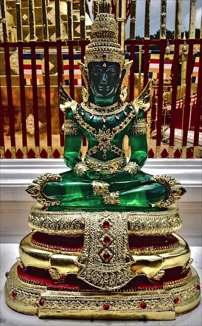
Allegory
an artistic form that can be perceived by the senses and represents something else, an object that symbolises something spiritual or general, syn. 'allegory' or 'symbol'; the dove is the symbol of innocent love and peace.
- Van Dale dictionary
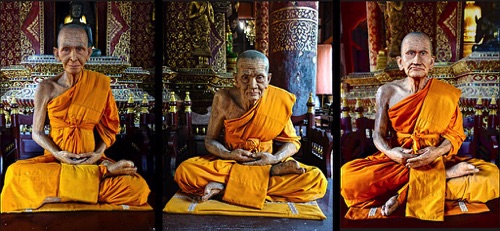


Having possibly spent their entire lives contemplating the transience of earthly existence, they were immortalised in wax and canonised.
These ‘heroes and saints’ are no longer studied with scepticism. Only then is one truly dead and ready for Mme Tussaud's theatre: come and see, come and worship.

Jonathan Cook argues that science has become a dominant belief system, akin to a new religion. He considers the relentless pursuit of technological solutions to be a problematic cultural trend.
Wendell Berry summed up this 'modern mentality' perfectly: 'A mystery is nothing more than an area that science has not yet reached.' Until then, it apparently does not exist, or is not real: ‘Any analogical connection is nonsense. Only causal connections exist because they are demonstrable.’
- One hundred and eight begging bowls.
Religious movements sometimes hoped to prevent personified faiths by giving the embodiment an elephant head (Ganesh), or a blue body colour (Krishna), or ten thousand and eight arms (Lokeshwar).
That cannot be taken literally – or so one would think.
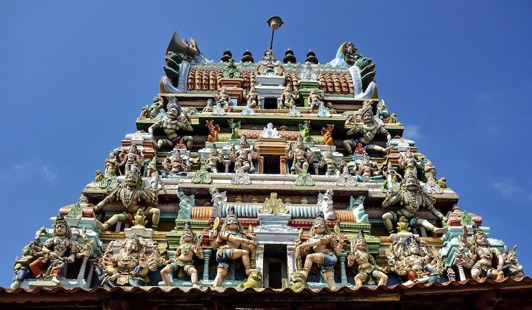
‘Oh, if only it were true that they had created us... surely the world would be a much better place.’ - J. Krishnamurti
27 May 2022 17:45
All photographs and texts ©Kashba Ais Loupatty & Ton Lankreijer.Webdesign:William Loupatty

The sudden intimacy with their faces turned the viewer into an unashamed voyeur.
Until around 1900, sculptures, drawings and paintings were the primary means of explanation – or admonition – for the masses who were unable to comprehend life.
How life and the afterlife worked was therefore taught by means of signs (icons), symbols and ‘picture gazing’.
The stories surrounding the Christmas crib or Stations of the Cross were not very different from, for example, the wheel of life at the entrance to every Tibetan monk temple.
At the same time, the clergy liked to be depicted amidst all of it. It indicated that the noble gentlemen priest were spiritually superior to worldly power. If the mass prayed to them, so much the better – you never know.
Allegedly, the Mediators between Heaven and Earth are merely depicted as edifying examples and sources of spiritual support – an alibi as contrived as religion itself.
Places of spiritual tranquillity in a society are often pleasant but also very necessary.
If their décor is somewhat spiritually inspiring, so much the better.
But then surely without historical figures, such as saints in churches and heroes in parks.
‘Why Heroes are Important’ is the title of an article on the website of the Catholic Santa Clara University in Silicon Valley. ‘First and foremost, we need heroes because our heroes help define the limits of our aspirations.’
When I think of ‘borders’ I think of limitation, but anyway.. The university was struggling with new research findings that showed that Mahatma Gandhi and Martin Luther King were not the top heroes, but Superman and Spiderman. But it can always be worse, especially in the US.
Just this week, director Spike Lee lamented the fact that, while his generation grew up idolizing great civil rights leaders, today young people in his community aspire to become pimps and strippers. - SCU (januari 2000)
With his remark that the Beatles were “more popular than Jesus”, John Lennon incurred the wrath of the United States' Bible Belt in 1966. Their records were burned, their music banned, and in some southern states the Ku Klux Klan blocked their performances.
‘At a series of press conferences, Lennon apologised and explained that he was not comparing himself to Christ.’ - Wikipedia.
He should have asked himself out loud: What would Jesus have done in my situation?
Pulling yourself up to others is essentially no different from kicking others down, as both are based on comparison.
But alas.. ‘they don’t make jews like Jezus anymore.'
‘Who is the most famous person in the world?’ This was the question posed by a university study in the mid-1970s. The Newsweek article on the results was unmistakably dismayed. The editors apparently assumed that Jesus would be number one, with perhaps Mohammed or Buddha in second place.
‘We are cynical’ the Santa Clara University analyses the result, ‘because so often our ideals have been betrayed. Washington and Jefferson held slaves, Martin Luther King is accused of philandering and plagiarizing, just about everybody had sex with someone they shouldn't, and so on.’
Or do we become ‘cynical' because we compare ourselves..?
We need to separate out the things that make our heroes noteworthy, and forgive the shortcomings that blemish their heroic perfection.
The Catholic makes it complicated here: he remains our hero thanks to our forgiveness—he remains family.
Those who like to make the world ‘uniform’ – conveniently so – banish all imagination. Large companies in particular take the world’s inhabitants as literally as possible.
Just a few decades ago, the word “pragmatic” (as in useful and of use) was considered almost offensive when used to describe someone. Nowadays, it is sometimes listed as a requirement in job advertisements.
The heroes of these pragmatists must be unambiguously clear-cut. Therefore, mainly sports, music and film stars fit into their media world.
Recognising that differences in form demonstrate that everything is interconnected and calls for modesty is not
of any use.
The design may not suit your ideas or taste – even Buddha statues have been subject to fashion trends over the centuries – but a symbol can never be kitsch in itself.
It does not pretend to be something it is not.
Nor does it try to please.
It merely refers.
A catholic website arguing that 'we have images of kings and presidents, so why not of Jesus and Mary?' has lost its way - away from God.
Personified images – such as a handsome white Jesus with a trim beard – belong to the same category of kitsch as the wax figures of monks in the accompanying photographs.
Life-size wax figures of three deceased monks, displayed in the temple, Thailand.
Until then, it apparently doesn't exist or not really: 'Any analogical connection is nonsense, there is only a causal connection because it can be demonstrated.'
In short, you can only refer to a mystery.
At most, another dimension can only be depicted with an emblem.
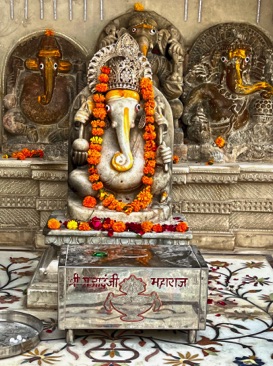
But even giving visual expression to hundreds of ideas – each idea with its own face – did not or hardly led to god inflation – many continue to worship them all.
It was once given its own name: symbol blindness.

Berry argues that religion, art, and mystery are not merely scientific unknowns but are distinct and valuable dimensions of life itself, resistant to being fully explained by science.

